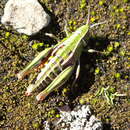zh-TW
在導航的名稱


Alpinacris tumidicauda is a species of grasshopper only known from Otago and Southland, New Zealand. The genus Alpinacris is endemic to the South Island of New Zealand. A. tumidicauda was described in 1967 by Robert Sidney Bigelow,[1] with a type locality of Obelisk (Māori: Kopuwai) in the Old Man Range (). A male holotype and paratype are deposited in the Canterbury Museum, Christchurch. Like all of New Zealand sub-alpine and alpine grasshoppers, A. tumidicauda has a 2- or 3-year life cycle. The eggs must "overwinter" before they will hatch. Hoppers are found throughout the year, and adult grasshoppers can be found throughout the New Zealand summer between December and April. The adult A. tumidicauda do not overwinter.
Alpinacris tumidicauda is known only from the Otago and Southland regions of New Zealand.[2] It can be found as far south as Cleughearn Peak () and as far north as Mount Aurum (). Alpinacris tumidicauda prefers alpine tussock grasslands between 1,300 and 1,700 metres (4,300 and 5,600 ft); it can, however, be found as low as 700 metres (2,300 ft) near the Nevis River (). It is one of three known species of alpine grasshoppers that are found in Fiordland, the other two being Sigaus homerensis and Sigaus takahe.[3]
Alpinacris tumidicauda has a "sister species", Alpinacris crassicauda. There would have originally been only one species of Alpinacris in the South Island; however, the Alpine Fault has separated this species over time, so at the present there are two species—A. tumidicauda in southeast of the South Island and A. crassicauda in the northwest of the island.[4][5]
A. tumidicauda is micropterous (small-winged), with wings measuring between 2 and 4 millimetres (0.079 and 0.157 in), making this species flightless like most New Zealand grasshoppers. Male body length is 12–14 millimetres (0.47–0.55 in); female body length is 21–24 millimetres (0.83–0.94 in).
Four colour morphs are known for adult A. tumidicauda: green, olive, dark olive and yellow-brown. The most common colour morph is green, followed by the yellow-brown colour morph.
Alpinacris tumidicauda is a species of grasshopper only known from Otago and Southland, New Zealand. The genus Alpinacris is endemic to the South Island of New Zealand. A. tumidicauda was described in 1967 by Robert Sidney Bigelow, with a type locality of Obelisk (Māori: Kopuwai) in the Old Man Range (). A male holotype and paratype are deposited in the Canterbury Museum, Christchurch. Like all of New Zealand sub-alpine and alpine grasshoppers, A. tumidicauda has a 2- or 3-year life cycle. The eggs must "overwinter" before they will hatch. Hoppers are found throughout the year, and adult grasshoppers can be found throughout the New Zealand summer between December and April. The adult A. tumidicauda do not overwinter.
Alpinacris tumidicauda is een rechtvleugelig insect uit de familie veldsprinkhanen (Acrididae). De wetenschappelijke naam van deze soort is voor het eerst geldig gepubliceerd in 1967 door Bigelow.
Bronnen, noten en/of referenties